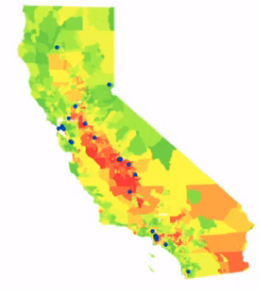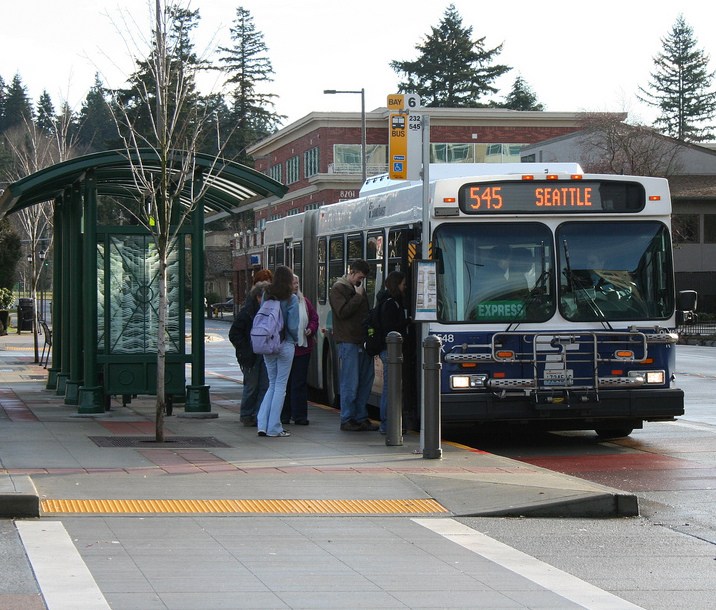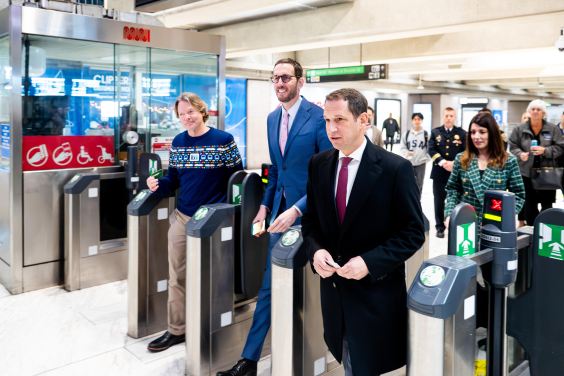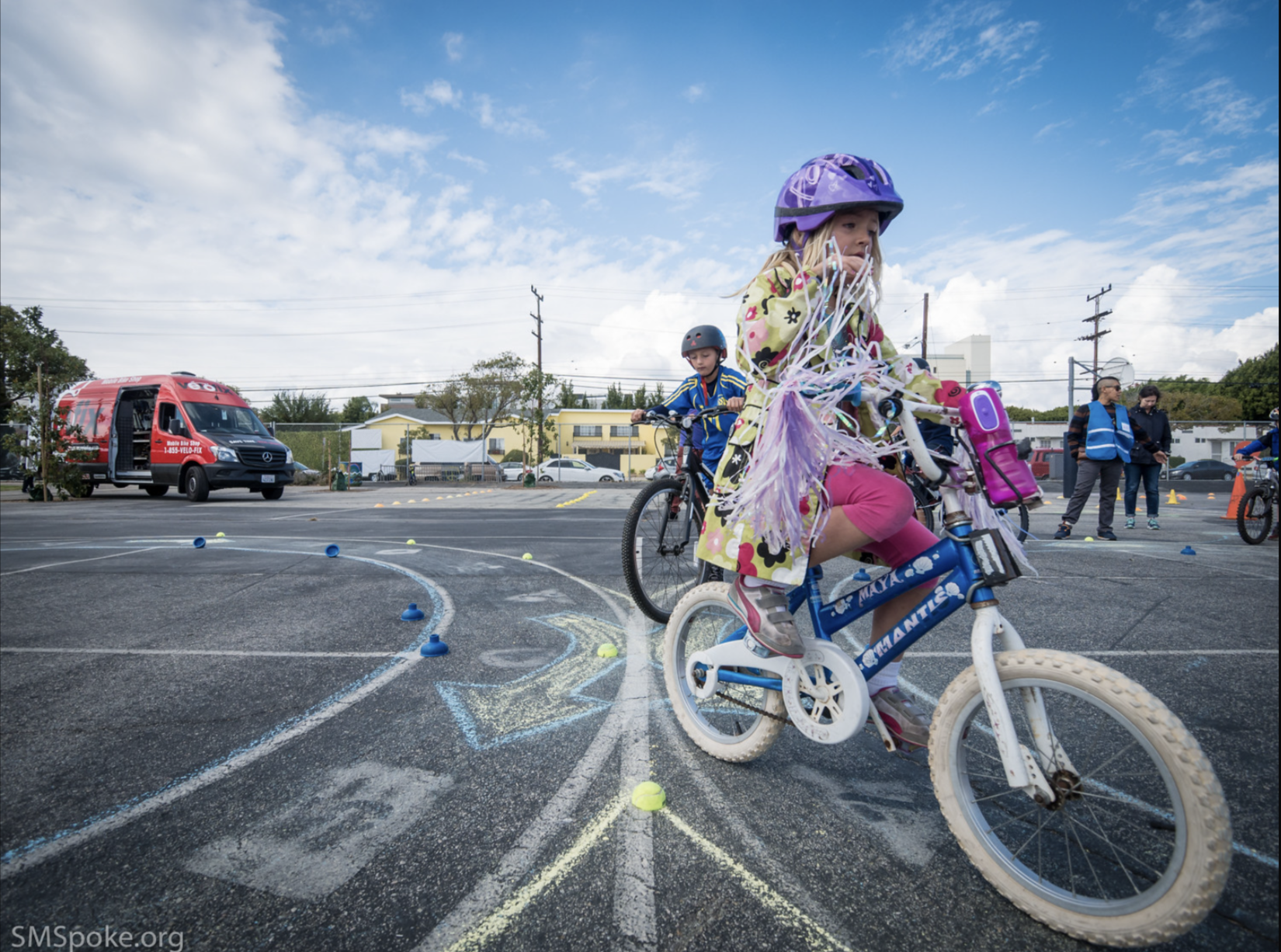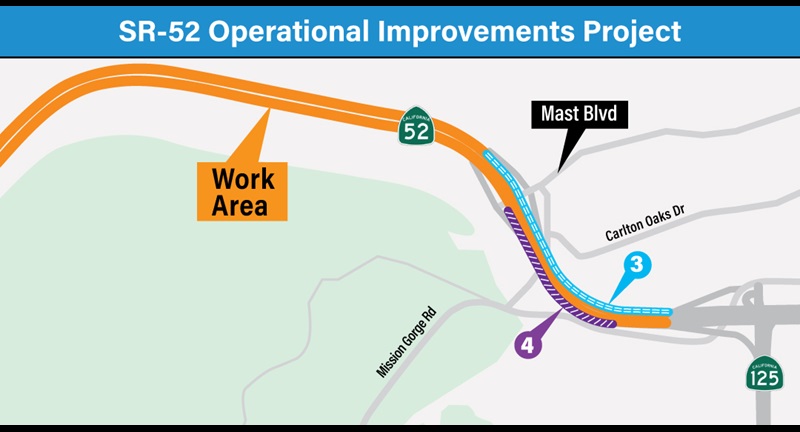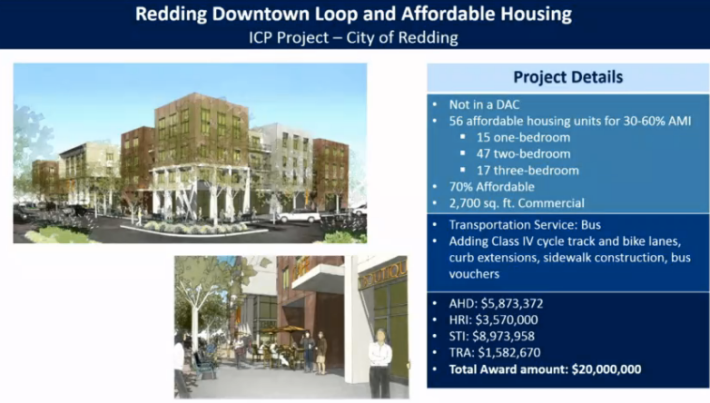
Today the Strategic Growth Council approved 25 projects for funding under the Affordable Housing and Sustainable Communities (AHSC) program. All of them combine affordable housing development and transportation improvements for either transit, walking, biking, or a combination of all three modes.
The council also briefly discussed preliminary rulemaking for a new program, the Transformative Climate Communities program (TCC), and draft guidelines for a pilot grant program to encourage local governments and agencies to plan for sustainable development.
The TCC is funded from a one-time allocation of $140 million from cap-and-trade as specified by A.B. 2722. Currently the proposed rulemaking calls for investing half of the money in Fresno, 25 percent in Los Angeles, with the remaining portion to be determined. Representatives from Fresno, including Mayor Ashley Swearingen and Assemblymember Joaquin Arambula, showed up to praise this decision to invest in Fresno's efforts to revitalize itself.
There will be a meeting on the proposed rulemaking, which precedes development of guidelines, on November 7 in Fresno. The SGC is welcoming comments until then by email to: tccpubliccomments [at] sgc.ca.gov
The main event at today's meeting was the vote on AHSC allocations. The goal of the AHSC program is to reduce greenhouse gas emissions and vehicle miles traveled by bringing housing closer to destinations and providing ways for residents can get around without adding to the overall amount of driving. This is in keeping with the program's funding source, the Greenhouse Gas Reduction Fund, which is fed by money the state raises through its cap-and-trade program.
The projects recommended by staff and approved today by the council—see list after the jump—went through a complicated scoring process that took into account the presence of disadvantaged communities and differing urban and rural needs and realities. The approved projects are more or less evenly distributed throughout the state, with a similar number of projects awarded in the Bay Area, L.A., and across the Central Valley, with a few scattered farther north and throughout the state.
From an original 130 concept proposals, staff narrowed the field to 74 invited applicants requesting a total of $691 million. Of those, 25 projects were awarded a total of $289 million. The AHSC is one of the few sources of funding for affordable housing since Governor Brown closed redevelopment agencies, and this amount doesn't come close to fulfilling the need.
Comments at the meeting reflected frustration from applicants who were not awarded funds, but there were other issues raised about this second round of funding.
A host of complaints were about a staff decision to apply trip generation rates for “retirement communities” to senior housing projects. Deputy Director Allison Joe explained that the decision made projects that included senior housing less competitive, and commenters said they were blindsided by the change. Staff agreed that the conversation on how to settle the question would be “ongoing.”
Several commenters argued that two specific projects should not be funded. One of them, in Wasco, is a plan to relocate farmworker housing to an area that is less isolated from the rest of the community and easier to access via transit. Commenters said that, although this was clearly a worthy project, it was made necessary by the planned path of high speed rail—and therefore should be funded with high speed rail funds, leaving more money in the pot for other projects.
Board members seemed satisfied by the staff explanation that the High Speed Rail Authority's original plan was not to relocate the housing but to erect a sound wall, which would have further isolated the farmworker housing. Instead, said staff, project proponents worked to find a better solution, and the HSRA will contribute the money slated for the wall towards completing the project.
Also, the Lakehouse Connections project in Oakland was strongly opposed by a representative of Eastlake Community Partners, who said that the affordable housing included in that project was only small part of a thirty-story luxury housing development on the same parcel, and had been added only after a hard-fought community battle. “The Strategic Growth Council needs to seriously tackle the issue of displacement,” she said.
Just before voting to approve all 25 projects, the board touched on the issues that had been raised. Councilmember Matt Rodriguez said to the audience, “I want you to know that we did hear your comments, and we will continue this conversation.”
Councilmember John Laird noted that “it's important to move ahead, but also to note these changes. As this program evolves, we need to make sure that we listen to that.”
Ken Alex, Council Chair, sounded a different note of warning. “The function of this council is to reduce greenhouse gas emissions,” he said, saying they had succeeded in reducing GHGs by 350,000 tons a year through the AHSC program. The $289 million awarded this year was “less than we anticipated having at the beginning of the year,” he said, in part because this year's cap-and-trade auctions did not raise as much money as had been hoped. “We need to ensure cap-and-trade program remains robust as we go forward,” he said.
All of the projects are mapped on TransForm's Climate Benefits site. $289 million was allocated to the following projects:
- Los Angeles: 7th & Witmer: $16,760,00076 supportive housing units in transit-oriented neighborhood, pedestrian lights, street trees and sidewalk, curb extensions, bus zones, bike share station
- Los Angeles: MDC Jordan Downs: $11,969,111135 units, extending Century Boulevard through community as a complete street with traffic calming, wide sidewalks, bike lanes, shade trees, rerouted bus line
- Los Angeles: PATH Metro Villas: $13,750,183122 units affordable housing near Metro Red Line, sidewalk improvements, “bike enhanced network street"
- Los Angeles: Six Four Nine Lofts: $5,315,00055 new affordable units and health clinic
- Los Angeles: Rolland Curtis West: $5,668,07470 units affordable housing, bike and pedestrian enhancements near USC
- Santa Ana: Santa Ana Arts Collective: $12,028,626converts commercial building to 58 units of affordable housing, converts nearby street to bike and pedestrian enhanced street.
- Turlock: Avena Bella Phase 2: $1,661.66761 affordable units, additional bus to improve transit frequency
- Truckee: Coldstream Mixed Use Village: $10,682,14048 multi-family and 50 unrestricted units, improved bus stop, 2 miles of class I bike lanes, roundabout
- San Francisco: 455 Fell $16,065,563108 units of affordable housing, sidewalk and street improvements
- Oakland: Coliseum Connections: $14,844,762110 mixed-income multifamily units next to BART, half below market rate
- Oakland: Empyrean & Harrison Hotel: $16,807,556rehabilitation of two historic SROs, 100 percent affordable, new bike lanes and bike share station, new hybrid bus to help AC Transit expand service
- Oakland: Lakehouse Connections: $18,127,20391 affordable units, new bus, bike, pedestrian network connections to downtown, uptown, and east Oakland (four sustainable transportation improvement projects and active transportation)
- Berkeley: Grayson Street Apartments: $3,755,326new mixed-use infill, 2000 sf commercial, 23 affordable apartments, new hybrid bus for AC transit to increase service on local route, transit passes and bike education
- Davis: Creekside Affordable Housing: $11,881,74890-unit affordable housing project for disabled, homeless, others
- Stockton: Hunter Street Housing: $8,941,370mixed-use development—office space and 74 affordable units, road diet
- Fresno: Kings Canyon Connectivity Project: $15,579,426135 affordable family and senior units, walking and bike paths, workforce training program
- Fresno: South Stadium: $5,738,73051 residential units plus retail/office; 20 percent affordable, wider sidewalks, standard and protected bike lanes, pedestrian-oriented lighting, bike/pedestrian wayfinding
- Lindsay: Lindsay Village: $5,518,35349 affordable rental units, vanpool and public transit program for residents, sidewalks, bike lanes, traffic calming, solar offset and gray water recycling system
- El Cajon: Cornerstone Place: $12,090,71370 units affordable housing for families, veterans, energy efficiency, increased service on local bus lines
- Redding: Downtown Loop: $20,000,000Redevelop existing commercial building into mixed-use with 79 affordable housing units near active transportation network. Converts three streets to complete streets, adds protected bike lane, bus pass subsidies to tenants
- San Jose: Renascent San Jose: $14,979,486160-unit infill affordable housing, 2 miles of bike/pedestrian trails, street trees, free bike repair and training
- San Jose: St James: $12,889, 611135 units of affordable housing, pedestrian and bicycle improvements, transit
- Dinuba: Sierra Village: $4,646,73143 affordable units, solar and water efficiency, vanpool, sidewalk and bike lane improvements
- Sun Valley: Sun Valley: $11,110,02096 housing units for senior veterans, community spaces, new sidewalks, ramps, crosswalks, curb extensions, lighting, new bike lane and shuttles to transit
- Wasco: Wasco Farmworker Housing: $18,637,432Moves 160 farmworker families closer to basic amenities, like day care, clinic, planned elementary school, shuttle to shopping and Amtrak, covered and secured bike storage, sidewalks and dedicated bike lanes
